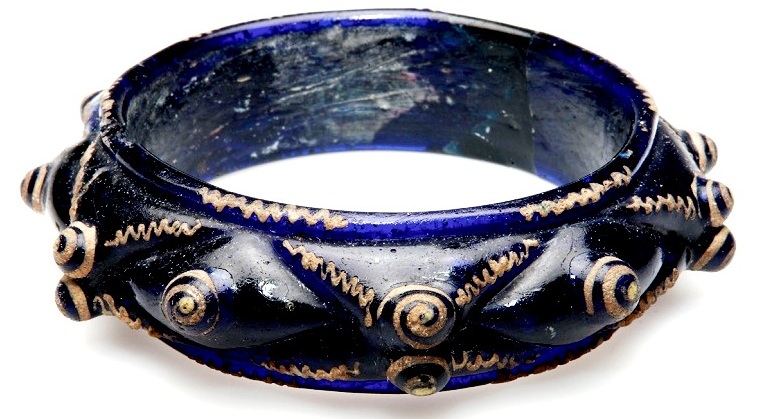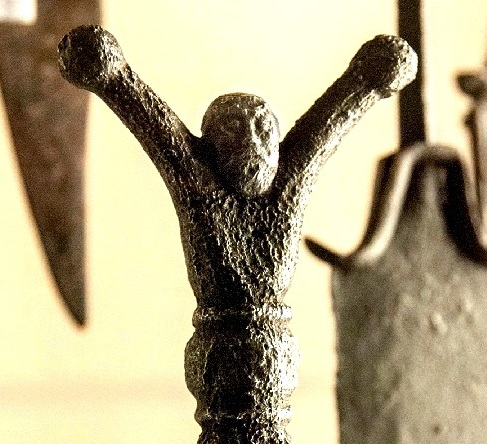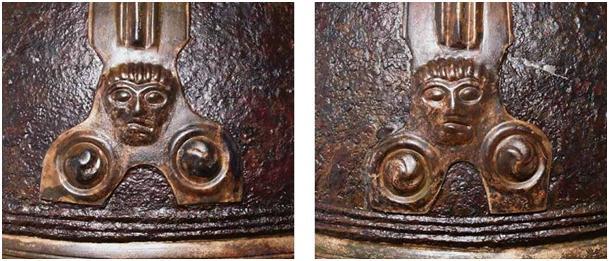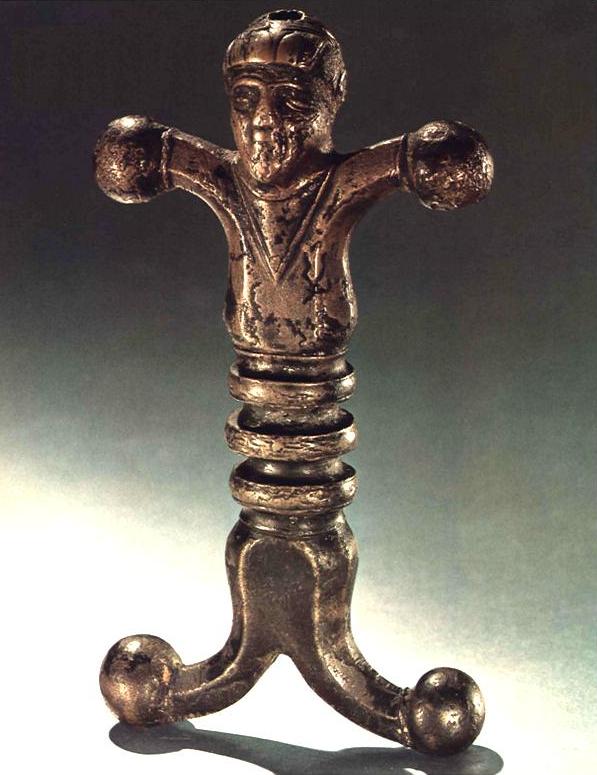UD: April 2019

With its origins in the Bronze Age, one of the most mysterious phenomena in Celtic Europe is the practice of ‘Killing the Objects’ – the deliberate bending, breaking or otherwise deforming of weapons and other artifacts before depositing them in burials or as votive offerings at religious sanctuaries (on this practice see also Pleiner R., Scott, B. G. (1993); Kurz, G. (1995); Bradley R. (1998); Megaw J.V. (2003).

The Gleninsheen Gorget from the Burren (Clare), Ireland (800-700 BC)
Ridges on the right hand side of the dazzling gold collar show that it was roughly bent in two before it was thrust into a rock fissure. Most of the other eight surviving examples of such collars were “decommissioned” in a similar fashion before being deposited.

Ritually ‘killed’ swords recorded in the British Isles and Iberia from the late Atlantic Bronze Age
https://www.academia.edu/22189046/Beakers_into_Bronze_Tracing_connections_between_Iberia_and_the_British_Isles_2800-800_BC

Ritually killed sword (iron with gold inlay) from an early Iron Age Celtic chieftain’s burial at Oss in the southern Netherlands. (ca. 700 BC)

‘Sacrificed’ Iron weapons from the sanctuary at Gournay-sur-Aronde (France)
(3rd c. BC)
Musée Antoine-Vivenel (Oise, France)

Ritually killed weapons (sword/scabbard and spearhead), razor and shears, from a Celtic warrior burial at St. Johann (Württemberg) in southern Germany (3-2 c. BC)

Ritually killed – bent / folded iron sword from Celtic warrior burial #59 at Gyöngyös in northeastern Hungary
https://balkancelts.wordpress.com/2017/09/02/expansion-and-symbiosis-a-major-celto-scythian-settlement-and-burial-complex-from-the-matra-mountains-in-north-eastern-hungary/
The ritual of Killing the Objects appears on the Balkans with the Celtic eastwards expansion of the late 4th – 3rd c. BC, with numerous examples recorded from Celtic burials stretching from the Adriatic Sea in the west to the Black Sea in the east. Examples have also been found north of the Carpathians at sites such as Korytnica in southeastern Poland and Mala Kopanya hillfort (7 ritually ‘killed’ late La Têne swords – Kazakevich 2012) in western Ukraine.

Ritually killed La Têne sword from Mala Kopanya in western Ukraine (1st c. BC/1 c. AD)

Ritually ‘Killed’ Spearhead from the Celtic (Scordisci) burial at Sremska Mitrovica, Serbia
see: https://balkancelts.wordpress.com/2012/11/04/the-warrior-and-his-wife-a-scordisci-burial-from-serbia/

Ritually ‘Killed’ Sword from Korytnica, (Świętokrzyskie Voivodeship), south-central Poland (1st c. BC)
see: https://balkancelts.wordpress.com/2013/02/09/the-celts-in-poland/
This practice was a common one in Thrace with examples of ‘killed’ weapons having been recorded in numerous Celtic warrior burials discovered on the territory of today’s Bulgaria, ranging from the 3rd c. BC onwards, such as those at Plovdiv (Bospacheva 1995), Kalnovo (Shumen region) (Ananasov 1992), Sofia (Kazarow 1926:41), or Kazanlak/Sevtopolis (Getov 1962). A particular high concentration of burials with ‘killed’ weapons comes from Scordisci territory in north-central and north-western Bulgaria (see: https://www.academia.edu/5385798/Scordisci_Swords_from_Northwestern_Bulgaria ).
The latest recorded evidence of this practice comes from the Stara Planina (Balkan) mountains of central Bulgaria where the ritual is to be observed at sites such as Taja (Stara Zagora reg.), where ritually killed La Têne swords and other Celtic weapons have been found in burials dating to the 3rd/4th c. AD (Domaradski 1993), indicating that in certain parts of Thrace some Celtic groups retained their independence and identity into the late Roman period.

Celtic burial goods including ritually ‘killed’ weapons from northeastern Bulgaria.
(Varna Archaeological Museum)

Ritually ‘killed’ Celtiberian La Tène sword from the Celtiberian necropolis at Quintanas de Gormaz, Soria, Castile and León, Spain (4/3 century BC)

Ritually killed iron sword from a Balkan Celtic warrior burial at Kupinovo (Syrmia), Serbia
(3rd c. BC)
CULT SITES
Besides weapons and other artifacts found in Celtic burials, the ritual of ‘killing the objects’ is also to be observed at Celtic cult sites across Europe.


Sacrificed weapons and lead votive ‘Taranis Wheels’ (see Taranis article) from Nanteuil-Sur-Aisne in the territory of the Remi tribe in Gaul (2nd/1st c. BC)
http://www.gaulois.ardennes.culture.fr/accessible/en/uc/05_01_01-Nanteuil-sur-Aisne
In about 200 BC, damaged weapons, hammered and broken on purpose, were placed in a geometric pattern on the ground at the edges of the sacred site, and buried immediately. The large oval ditch surrounding the temple also contained the remains of weapons, belt buckles and tools, as well as human bones. In the early 1st century BC, such votive wheels, made of gold, silver, potin, bronze and especially lead, replaced the deposits of weapons.

Ritually ‘killed’iron sword from the Gaulish sanctuary at Gournay-sur-Aronde, France (2 c. BC)
In Thrace the custom of ‘Killing the Objects’ is to be observed particularly at cult sites in the Rhodope and Stara Planina (Balkan) mountains of central and southern Bulgaria. Recent publications of excavations from the Rhodope mountains provide conclusive proof that this Celtic practice was common among the local population there in the 3rd – 1st c. BC. Votive offerings (Torcs, ceramic vessels, fibulae, daggers etc.) at cult sites such as Tsruncha (Smolyan region), Koprivlen and Babyak (both Blagoevgrad region) (Christov 1999; Kisyov 1990;Tonkova, Gotcheva 2008) etc. show clear evidence of having been ‘killed’ in the typical Celtic fashion.

Reconstruction of a ritually killed Celtic ‘cult’ fire-pot found at Babyak, Rhodope mountains (Southwestern Bulgaria)
(see: https://www.academia.edu/5046182/Zoomorphic_Cult_Firepots )
Thousands of examples of this practice have been recorded across Europe, indicating that it was a ritual common to all the pan-Celtic tribes. However, although many theories have been postulated, for now the exact significance of this mysterious custom remains unclear.

Ritually ‘killed’ iron Celtic dagger recently discovered by treasure hunters at Bulbuc (Alba County), Transylvania (late 2nd/early 1st c. BC)
(see : https://balkancelts.wordpress.com/2012/11/24/curved-sacrificial-daggers/ )

Ritually ‘killed’ blacksmiths tools (anvil, tongs, sledge hammer, chisel and poker) found deposited in the River Lea at Waltham Abbey (Essex), England (1st century BC)
Sources Cited
Atanassov 1992 = Атанасов Г., Съорьжени от III– II в. Пр. н.е. от околностите на с. Кълново, Шуменско – ИИМШ,VII, 1992, с. 5-44
Bospacheva 1995 = Боспачиева М. Погилно погребение от елинистическия некропол на филипопол – Исвестия на музеите в Южна България 21, 43-61
Bradley R. (1998): The passage of arms. An archaeological analysis of prehistoric hoard and votive deposits. (2ed.) Oxford
Christov Iv., Rock Sanctuaries of MountainThrace. V. Tarnovo. 1999
Domaradski 1993 = Домарадски М., Могилен Некропол В М. Атанасца При С. Тъжа. In: Първи Международен Симпозиум “Севтополис”, Надгробните Могили в Югоизточна Европа. Казанлък, 4-8 юни 1993 г., Pp. 267 – 306.
Getov 1962 = Гетов Л., Нови данни за въорежението у нас през латенската епоха – Археология, IV, 1962, 3, c. 41-43, обр. 1-3.
Kazakevich G. (2012) Celtic Military Equipment from the Territory of Ukraine: Towards a new Warrior Identity in the pre-Roman Eastern Europe. In: Transforming Traditions: Studies in Archaeology, Comparative Linguistics and Narrative. Studia Celto-Slavica 6. p. 177- 212. Lódź.
Kazarow 1926 = Кацаров Г., България в древността. Историко-археологически очерк. Популярна археологическа библиотека, No. 1. София 1926
Kisyov 1990 = Кисьов К., Скални светилища в Родопите и Горнотракийската низина, представени с археологически материали и обкети от Смолянско и Пловдивско – Тракийската култура в Родопите е горните течения на реките Марица, Места и Струма. Смолян, 1990, 64-74
Kurz G. (1995) Keltische Hort- und Gwässerfunde in Mitteleuropa. Deponierungen der Latènezeit. Material hefte zur Archäologie in Baden-Würrtemberg 33. Stuttgart
Megaw J.V. Celtic Foot(less) Soldiers? An icongraphic note, Gladius XXIII, 2003, pp. 61-70
Pleiner R., Scott, B. G. (1993): The Celtic sword. Oxford.
Tonkova, Gotcheva 2008 = Тонкова, М. и Ал. Гоцев (eds.) Тракийското светилище при Бабяк и неговата археологическа среда. София 2008.
Mac Congail



































































